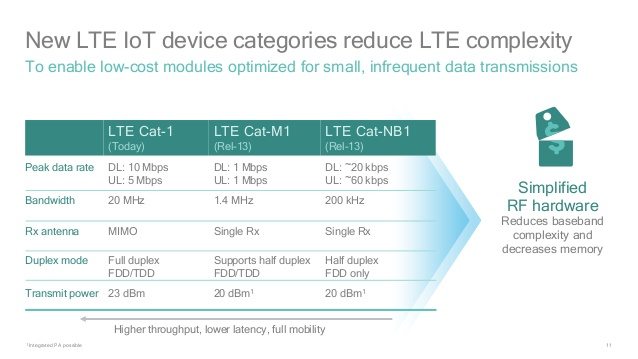Mobile network operators have been supporting machine-to-machine traffic for years, and as the internet of things grows, the cellular industry wants to play a central role. Verizon Wireless and AT&T have upgraded their networks to support the latest generation of LTE for IoT, and Sprint is not far behind.
Carriers are using low-power, low-cost variants of LTE called Category 1 and Category M1. The chips that enable these types of LTE are not built for high-speed video or for uploading big files to the cloud. The LTE that our smartphones use is not a fit for the internet of things.
“LTE for IoT is like a Ferrari on a dirt road,” explained Chris Moorhead, VP of strategic accounts for North America at Gemalto. “It’s too expensive, too big, too powerful, too power-hungry, it’s not what people wanted.”
What people wanted was an affordable solution for connecting low-cost machines and devices to the internet over cellular networks, and the lower categories of LTE can support this. Module makers like Gemalto embed Cat 1 and Cat M1 modems into their chipsets to give developers a way to connect assets and equipment to mobile networks. Makers of Cat 1 and Cat M1 modems include Sequans, which makes the modems used in Gemalto’s Cat1/Cat M1 modules, as well as Qualcomm and Altair Semiconductor, which is owned by Sony.
Altair co-founder Eran Eshed said both Cat 1 and Cat M1 are appropriate for connecting equipment or assets that need to be tracked while in motion. He said the excitement around the coming Cat M1 should not deter companies from launching Cat 1 solutions now.
“If you really want to deploy something reliable, that’s Cat 1, not Cat M1,” said Eshed. “Six to nine months from now Cat M1 will be a lot more mature.”
Cat 1 limits download speeds to 10 megabits per second and limits upload speeds to 5 megabits per second. Cat M1 caps both at 1 megabit per second. Cat 1 uses up to 20 megahertz of bandwidth while Cat M1 uses just 1.4 megahertz of bandwidth.
“You really have to understand your use case, how you want to use the devices to dictate which technology is right for you,” Gemalto’s Moorhead said. “If you really want a global solution, you can start with Cat 1.”
AT&T and Verizon Wireless now support both Cat 1 and Cat M1. Sprint will support Cat 1 later this year, and Cat M1 is coming next year. T-Mobile US has an IoT business but has not yet released a timeline for Cat 1 or Cat M1.
Image source: Sequans
Follow me on Twitter.

